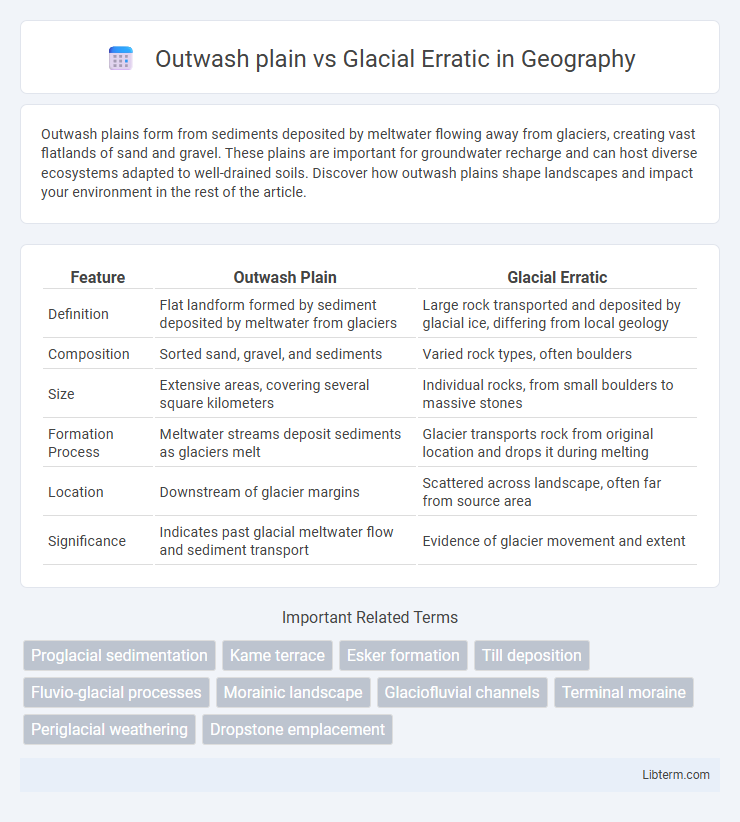Outwash plains form from sediments deposited by meltwater flowing away from glaciers, creating vast flatlands of sand and gravel. These plains are important for groundwater recharge and can host diverse ecosystems adapted to well-drained soils. Discover how outwash plains shape landscapes and impact your environment in the rest of the article.
Table of Comparison
| Feature | Outwash Plain | Glacial Erratic |
|---|---|---|
| Definition | Flat landform formed by sediment deposited by meltwater from glaciers | Large rock transported and deposited by glacial ice, differing from local geology |
| Composition | Sorted sand, gravel, and sediments | Varied rock types, often boulders |
| Size | Extensive areas, covering several square kilometers | Individual rocks, from small boulders to massive stones |
| Formation Process | Meltwater streams deposit sediments as glaciers melt | Glacier transports rock from original location and drops it during melting |
| Location | Downstream of glacier margins | Scattered across landscape, often far from source area |
| Significance | Indicates past glacial meltwater flow and sediment transport | Evidence of glacier movement and extent |
Introduction to Outwash Plains and Glacial Erratics
Outwash plains are broad, flat landforms composed of sediment deposited by meltwater streams flowing from glaciers, characterized by sorted sands and gravels. Glacial erratics are large rocks or boulders transported and deposited by glacial ice, often resting on bedrock different from their origin, highlighting past glacier movement. These features provide key insights into glacial dynamics and the processes of sediment transportation and deposition during ice age periods.
Defining Outwash Plains
Outwash plains are broad, flat areas formed by meltwater from glaciers depositing sediments like sand and gravel as the water slows. These plains differ from glacial erratics, which are large boulders transported and left behind by moving ice, often resting far from their source rock. Understanding outwash plains involves recognizing their role in shaping landscapes through sediment distribution in glacial environments.
What Are Glacial Erratics?
Glacial erratics are large rocks or boulders that have been transported and deposited by glacial ice, often differing significantly from the native rocks in the area where they are found. Unlike outwash plains, which consist of layered sediments like sand and gravel deposited by meltwater streams from glaciers, glacial erratics are isolated and can be traced back to a distant source region. These erratics provide important geological evidence for past glacial movement and the extent of ice sheets during the last Ice Age.
Formation Processes of Outwash Plains
Outwash plains form through the deposition of sediments carried by meltwater streams flowing from glaciers, creating extensive, stratified layers of sand and gravel. These plains develop as the glacial meltwater loses energy and deposits its load beyond the ice margin, often resulting in broad, flat landscapes shaped by braided river systems. In contrast, glacial erratics are large boulders transported and deposited directly by ice, highlighting the distinct sediment transport processes between water-driven outwash plains and ice-driven erratic placement.
Origin and Movement of Glacial Erratics
Outwash plains form from sediments deposited by meltwater flowing away from glaciers, creating sorted layers of sand and gravel. Glacial erratics originate when glaciers pick up rocks from one location and transport them over long distances before depositing them on different terrains. These erratics demonstrate the immense movement power of glaciers, often resting far from their source bedrock and providing evidence of past glacial paths.
Key Differences Between Outwash Plains and Glacial Erratics
Outwash plains are expansive, flat terrains formed by meltwater carrying and depositing sediments like sand and gravel downstream from glaciers, creating stratified layers. In contrast, glacial erratics are isolated boulders transported and deposited by glacial ice, often differing in composition from local bedrock. The key differences are that outwash plains consist of sorted sediment deposits spread over large areas, while glacial erratics are solitary, unsorted rocks positioned far from their source.
Geological Significance of Outwash Plains
Outwash plains, formed by sediment deposited from glacial meltwater, provide key insights into past glacial dynamics and sediment transport processes, revealing the extent and behavior of ancient ice sheets. These plains consist mainly of stratified sand and gravel, distinguishing them from the isolated, large boulders known as glacial erratics, which are transported and deposited by moving ice. Understanding outwash plains aids geologists in reconstructing past climates and sedimentary environments, essential for interpreting Earth's glacial history.
Ecological and Scientific Importance of Glacial Erratics
Glacial erratics serve as crucial ecological markers, providing unique habitats for specialized plant and animal species that thrive in the microenvironments created by these large rocks. Scientifically, they offer valuable data on past glacial movements and ice flow patterns, enabling researchers to reconstruct historical climate conditions and geological processes. Their mineral composition and provenance also contribute to understanding Earth's crustal dynamics and landscape evolution after glacial retreat.
Famous Examples Around the World
The Outwash Plain of Iceland's Skeidararsandur, spanning 1,500 square kilometers, exemplifies vast sediment deposition from glacial meltwater, while the Canadian Shield's Mackenzie River Outwash Plain showcases extensive gravel and sand spread from Ice Age glaciers. The Glacial Erratic named Big Rock in Alberta, Canada, stands as a massive 16,500-ton boulder transported over 190 kilometers from the Rocky Mountains by glacial ice. Finland's Hallingsan Erratic, a 90-ton granite boulder, is another prominent example of rocks carried and deposited far from their origin during glacial periods.
Summary: Outwash Plain vs Glacial Erratic
Outwash plains are broad, flat lands formed by sediment deposited by meltwater flowing from glaciers, characterized by layered sand and gravel deposits. Glacial erratics are large boulders transported and deposited by glacial ice, often differing significantly from the local bedrock. Both features provide critical evidence of past glacial activity but differ in formation processes and sediment characteristics.
Outwash plain Infographic

 libterm.com
libterm.com